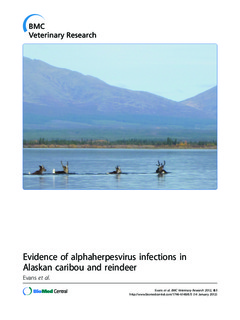| dc.description.abstract | Background: The reindeer (Rangifer tarandus tarandus) industry in Alaska began with animals imported from
Siberia (Russia) in the 1890’s. Cervid herpes virus 2 (CvHV2) is endemic in reindeer in Scandinavia. We sought to
determine if the same virus, or similar herpesviruses, were circulating in Alaskan reindeer and caribou (Rangifer
tarandus granti). Serum samples from 292 reindeer were collected during annual reindeer handlings (1988-2005)
near Nome, Alaska. In 2005, swab samples were collected from 40 calves from this herd, near Nome, Alaska. In
2007, ocular and nasal swab samples were collected from 30 apparently healthy reindeer calves near Wales, Alaska.
Samples of plasma and white blood cells were collected from three Alaskan caribou herds, Mulchatna (n = 24),
Teshekpuk (n = 34) and the Western Arctic (n = 87) in 2009.
Results: Of 292 reindeer samples tested by ELISA for antibodies against alphaherpesvirus (bovine herpesvirus 1 as
antigen), seroprevalence was 47% (136/292) and adult reindeer had higher seroprevalence than yearlings. The
overall seroprevalence for caribou was 60% (87/145), with no significant differences among caribou herds. A virus
neutralization test of 20 samples from both reindeer and caribou showed that ELISA positive samples always
neutralized CvHV2 to a greater extent than BoHV1 or elk herpesvirus (ElkHV), indicating that CvHv2 is the most
likely virus circulating. PCR of nasal and ocular swabs sampled from 30 reindeer calves in Wales, Alaska (2007)
yielded four CvHV2 positive samples. PCR amplicons of the expected size (294 bp) were obtained from 2 of the 36
buffy coats samples from caribou, and the amplicon sequences were consistent with CvHV2.
Conclusions: This study shows that Alaskan reindeer and Caribou are infected with an alphaherpesvirus. Based on
sequence similarity, CvHV-2 is the most likely virus. Further studies should be conducted to determine the impact
of this infection on the health of these animals. | no_NO |
